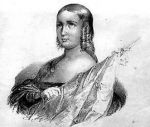Mariana Pineda
Biography:
Daughter of Mariano de Pineda y Ramírez, Captain of the Royal Navy in Granada and knight of the Order of Calatrava, and María Dolores Muñoz y Bueno, a couple who never married, perhaps because she was much younger and belonged to a lower social class. Mariana was considered an illegitimate daughter and grew up with a tutor. The latter took part of the assets inherited from her father for his own daughter, an embezzlement that pushed Mariana to take legal action several times during her life, in order to recover her belongings.
She was a beauty but not typically Andalusian, with blonde hair and blue eyes. In October 1819 at the young age of fifteen she married Manuel de Peralta y Valle, a man eleven years her senior who had just left the army. She had two children and was widowed in 1822. It was at that time, coinciding with the Trienio Liberal (Liberal Triennium), that Mariana joined the liberal cause. When absolutism returned with Fernando VII in 1823, she surrounded herself with people who were being pursued on account of their stance against the monarchy. Among her new friendships she met a soldier whom she was going to marry. For a period she disappeared from Granada to avoid clashes with the authorities, but when she returned, her home became a refuge for the persecuted, she acted as a liaison for those hiding and fleeing from the Guard of Fernando VII, she helped her cousin to escape from prison and carried compromising letters and messages that led to her first punishment of house arrest.
The police were convinced that she was directly or indirectly involved in the preparation of an uprising led by the exiled liberal generals José María Torrijos and Francisco Espoz y Mina. The date of 20th March 1831 was set, but the preparations were discovered and the attempt was ruined. Two days before the planned date of the uprising, on March 18th 1831, police burst into Mariana’s home on Calle del Águila in Granada, where they found a half-embroidered flag which they interpreted as the motto of the uprising: a green triangle on a purple background, surrounded by the words freedom, equality, law. With this proof the public prosecutor imputed the crime of rebellion against order and the monarchy to her, punishable with the death sentence.
Her trial was held behind closed doors, and she was only granted one day to find out about the trial and prepare her defence. Her lawyer tried to dismantle the accusation that the flag was revolutionary, claiming that actually it was a flag supporting Freemasonry, and since women could not belong to Freemasonry, it was understood that she would be freed of blame, or only receive a prison sentence. This appears to have been Mariana’s main activity during the previous months: being in contact with Freemasons who, undoubtedly, were related and confused with the liberals who were plotting an uprising from the south of the country. Eventually she was given the death sentence by public garrotting, and was given the option of being pardoned if she denounced the other comrades who were conspiring against the king. She did not do this. The firm commitment she acquired by not betraying her comrades turned her silence into a legendary act. She was buried anonymously without a cross or sign of any type, victim to the reactionary fury that had become widespread in the city. When the king died she became a heroine of freedom, and achieved extraordinary popular and literary fame. She went beyond the frontiers of myth and symbolised the ideal of freedom during the whole of the XIX century. Her memory lasted for years in clandestine circles and her attitude lived on in the form of ballads and stories, endorsed by popular memory through streets and squares with a folk song summarising what occurred:
¡Oh, qué día tan triste en Granada
Que a las piedras hacía llorar
Al ver que Marianita se muere
En cadalso por no declarar!
(Oh, what a sad day in Granada
Even the stones are crying
To see Marianita die
In the gallows for not declaring!)
Chronology:
1819: Mariana Pineda was married at the age of 15.
1820-22: Her two children were born and she became a widow.
1822: First contact with the sphere of liberal politics.
1823-1830: Clandestine social relations with Freemasons and liberals persecuted by the Granada police during the reign of Fernando VII (1823-1833).
1830: Preparations of an uprising that was to start in the south of Spain.
18th March 1831: Mariana Pineda was arrested, accused of keeping a revolutionary flag supporting the rebels in her house.
Sources of information:
-
Gálvez, Mª Ángeles y Sánchez, Paula (eds), (2008): La Granada de Mariana Pineda: lugares, historia y literatura, Granada: Universidad de Granada y Ayuntamiento. http://www.granada.org.es/obj.nsf/in/HDUNGCI/$file/Mariana_Pineda.pdf
-
Munch Comin, Elda (2000): Mariana Pineda, nuevas claves interpretativas desde la Teoría de Género. http://www.andalucia.cc/viva/mujer/mariana.html
-
Rodrigo, Antonina (1997): Mariana Pineda, heroína de la libertad. Madrid: Compañía Literaria.
-
Rodrigo, Antonina (2004): Mariana de Pineda: la lucha de una mujer revolucionaria contra la tiranía absolutista. Madrid: La Esfera de los Libros.
-
Serrano, Carlos (2000): “Mariana Pineda (1804-1831). Mujer, sexo y heroísmo”. En Burdiel, Isabel y Pérez Ledesma, Manuel: Liberales, agitadores y conspiradores. Biografías heterodoxas del siglo XIX. Madrid: Espasa Calpe.
Photo:
- Isidoro Lozano. Public Domain (copyright expired). City hall of Granada. http://commons.wikimedia.org/wiki/File:Mariana_pineda5.JPG.




